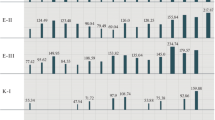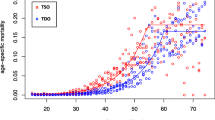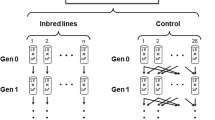Abstract
Spontaneous mutations are thought to have a stable rate for a given species. If non-adaptive, they appear at low frequencies and are governed by drift. However, environmental factors have been reported to cause spread of non-adaptive mutations in populations, governed by mechanisms, such as genetic assimilation. In the present study, we report a simultaneous appearance of a mutant and apparently non-adaptive C2 vein in Drosophila melanogaster at higher than expected frequencies in several distant populations, which excludes the role of drift or selection as the cause of the reported mutation frequencies. We discuss explanations of the phenomenon, including the role of external factors, such as temperature, in the possible genetic assimilation of the trait.
Similar content being viewed by others
References
Baer, C.F., Miyamoto, M.M., and Denver, D.R., Mutation rate variation in multicellular eukaryotes: causes and consequences, Nat. Rev. Genet., 2007, vol. 8, no. 8, pp. 619–631.
Yang, H.P., Tanikawa, A.Y., and Kondrashov, A.S., Molecular nature of 11 spontaneous de novo mutations in Drosophila melanogaster, Genetics, 2001, vol. 157, no. 3, pp. 1285–1292.
Watanabe, Y., Takahashi, A., Itoh, M., and Takano Shimizu, T., Molecular spectrum of spontaneous de novo mutations in male and female germline cells of Drosophila melanogaster, Genetics, 2009, vol. 181, no. 3, pp. 1035–1043.
Berg, R.L., A genetical analysis of wild populations of Drosophila melanogaster, Dros. Inform. Serv., 1941, vol. 15.
Kozeretska, I.A., Protsenko, O.V., Afanasyeva, E.S., Rushkovskii, S.R., Chuba, A.I., Mousseau, T.A., and Moller, A.P., Mutation processes in natural populations of Drosophila melanogaster and Hirundo rustica from radioactively contaminated areas, Cytol. Genet., 2008, vol. 42, no. 4, pp. 267–271.
Radionov, D.B., Protsenko, O.V., Andriyevskiy, A.M., Totsky, V.N., Kucherov, V.A., and Kozeretska, I.A., Stability of genetic parameters in a population of Drosophila melanogaster from Odesa, Cytol. Genet., 2011, vol. 45, no. 3, pp. 187–190.
Ayala, F.J., Genetic variation in natural populations: problem of electrophoretically cryptic alleles, Proc. Natl. Acad. Sci. USA, 1982, vol. 79, no. 2, pp. 550–554.
Kimura, M., The Neutral Theory of Molecular Evolution, Cambridge: Univ. Press, 1983.
Waddington, C.H., Genetic assimilation of an acquired character, Evolution, 1953, vol. 7, no. 2, pp. 118–126.
Parsons, P.A., Genes, behavior and evolutionary process: the genus Drosophila, Adv. Genet., 1977, vol. 19, pp. 1–32.
Roberts, D.B., Drosophila: A Practical Approach, 2nd ed., Oxford: IRL Press, 1998.
Zakharov, I.K. and Golubovskiy, M.D., The returning fashion for a yellow mutation in a natural population of D. melanogaster from Uman, Russ. J. Genet., 1985, vol. 21, no. 8, pp. 1298–1305.
Berg, R.L., A simultaneous mutability rise at the singed locus in two out of three Drosophila melanogaster population study in 1973, Dros. Inform. Serv., 1974, vol. 51, pp. 100–102.
Ivanov, Yu.N. and Golubovskiy, M.D., Increased mutability and the appearance of mutationally instable alleles of the locus singed in populations of D. melanogaster, Russ. J. Genet., 1977, vol. 13, no. 4, pp. 655–666.
Kondrashov, F.A. and Kondrashov, A.S., Measurements of spontaneous rates of mutations in the recent past and the near future, Philos. Trans. R. Soc. Lond. B, Biol. Sci., 2010, vol. 365, no. 1544, pp. 1169–1176.
Schertel, C., Rutishauser, T., Forstemann, K., and Basler, K., Functional characterization of Drosophila microRNAs by a novel in vivo library, Genetics, 2012, vol. 192, no. 4, pp. 1543–1552.
Lee, H., Yoo, S.J., Lee, J.H., Kim, W., Yoo, S.K., Fitzgerald, H., Carrington, J.C., and Ahn, J.H., Genetic framework for flowering-time regulation by ambient temperature-responsive miRNAs in Arabidopsis, Nucleic Acids Res., 2010, vol. 38, no. 9, pp. 3081–3093.
Cossetti, C., Lugini, L., Astrologo, L., Saggio, I., Fais, S., and Spadafora, C., Soma-to-germline transmission of RNA in mice xenografted with human tumour cells: possible transport by exosomes, PLoS One, 2014, vol. 9, no. 7, p. e101629.
Author information
Authors and Affiliations
Corresponding author
Additional information
The article is published in the original.
About this article
Cite this article
Kozeretska, I.A., Serga, S.V., Kunda-Pron, I. et al. A high frequency of heritable changes in natural populations of Drosophila melanogaster in Ukraine. Cytol. Genet. 50, 106–109 (2016). https://doi.org/10.3103/S0095452716020092
Received:
Published:
Issue Date:
DOI: https://doi.org/10.3103/S0095452716020092




